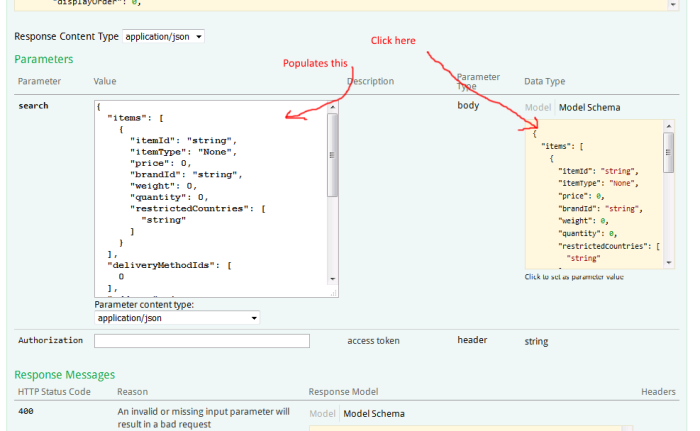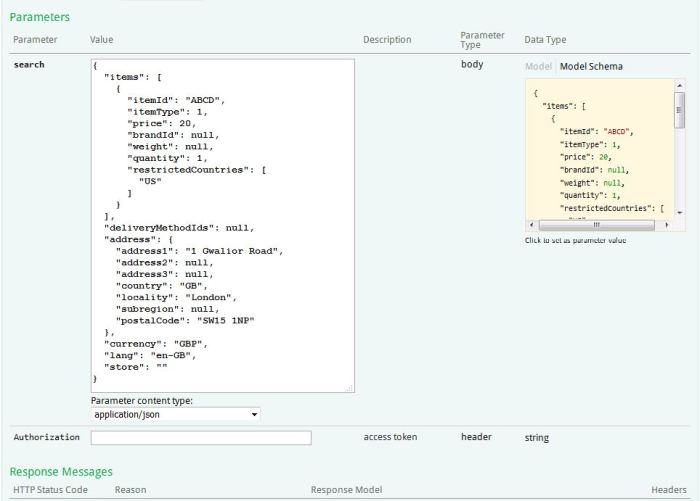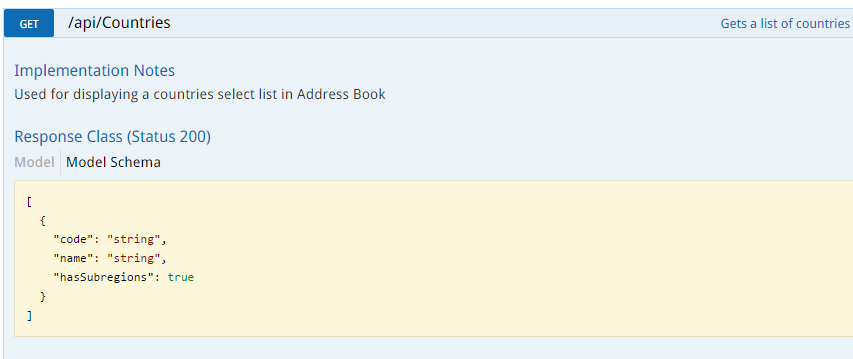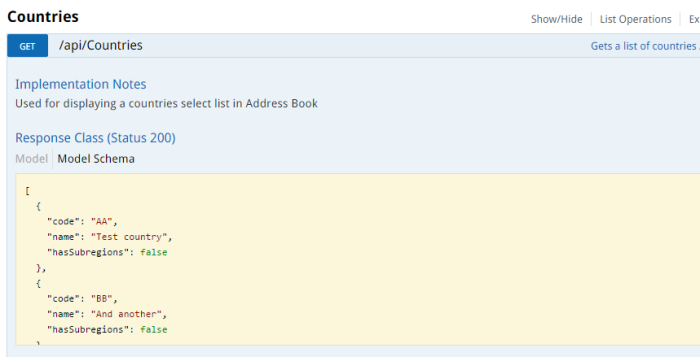A simple library which adds the [SwaggerRequestExample], [SwaggerResponseExample] attributes to Swashbuckle. Can also add read the [Description] attributes off your Response objects, and can also add an input box for entering an Authorization header.
Blog articles: https://mattfrear.com/2016/01/25/generating-swagger-example-requests-with-swashbuckle/ and: https://mattfrear.com/2015/04/21/generating-swagger-example-responses-with-swashbuckle/
Populate swagger's definitions.YourObject.example with whatever object you like.
This is great for manually testing and demoing your API as it will prepopulate the request with some useful data, so that when you click the example request in order to populate the form, instead of getting an autogenerated request like this:
You’ll get your desired example, like this:
You can see the example output in the underlying swagger.json file, which you can get to by starting your solution and navigating to /swagger/docs/v1
Allows you to add custom data to the example response shown in Swagger. So instead of seeing the default boring data like so:
You'll see some more realistic data (or whatever you want):
Lets you add a comment-like description to properties on your response, e.g.
Adds an input so that you can send an Authorization header to your API. Useful for API endpoints that have JWT token authentication. e.g.
Install the NuGet package, then enable whichever filters you need when you enable Swagger:
GlobalConfiguration.Configuration
.EnableSwagger(c =>
{
c.SingleApiVersion("v1", "WebApi");
// Enable Swagger examples
c.OperationFilter<ExamplesOperationFilter>();
// Enable swagger response descriptions
c.OperationFilter<DescriptionOperationFilter>();
})
Decorate your controller methods with the included SwaggerRequestExample attribute:
[SwaggerRequestExample(typeof(DeliveryOptionsSearchModel), typeof(DeliveryOptionsSearchModelExample))]
public async Task<IHttpActionResult> DeliveryOptionsForAddress(DeliveryOptionsSearchModel search)
Now implement it, in this case via a DeliveryOptionsSearchModelExample (which should implement IExamplesProvider),
which will generate the example data. It should return the type you specified when you specified the [SwaggerRequestExample].
public class DeliveryOptionsSearchModelExample : IExamplesProvider
{
public object GetExamples()
{
return new DeliveryOptionsSearchModel
{
Lang = "en-GB",
Currency = "GBP",
Address = new AddressModel
{
Address1 = "1 Gwalior Road",
Locality = "London",
Country = "GB",
PostalCode = "SW15 1NP"
},
Items = new[]
{
new ItemModel
{
ItemId = "ABCD",
ItemType = ItemType.Product,
Price = 20,
Quantity = 1,
RestrictedCountries = new[] { "US" }
}
}
};
}
In the Swagger document, this will populate the request's schema object example property. The spec for this says:
| Field Name | Type | Description |
|---|---|---|
| example | Any | A free-form property to include an example of an instance for this schema. |
Decorate your methods with the new SwaggerResponseExample attribute:
[SwaggerResponse(HttpStatusCode.OK, Type=typeof(IEnumerable<Country>))]
[SwaggerResponseExample(HttpStatusCode.OK, typeof(CountryExamples))]
[SwaggerResponse(HttpStatusCode.BadRequest, Type = typeof(IEnumerable<ErrorResource>))]
public async Task<HttpResponseMessage> Get(string lang)
Now you’ll need to add an Examples class, which will implement IExamplesProvider to generate the example data
public class CountryExamples : IExamplesProvider
{
public object GetExamples()
{
return new List<Country>
{
new Country { Code = "AA", Name = "Test Country" },
new Country { Code = "BB", Name = "And another" }
};
}
}
In the Swagger document, this will populate the response's example object. The spec for this says:
| Field Pattern | Type | Description |
|---|---|---|
| {mime type} | Any | The name of the property MUST be one of the Operation produces values (either implicit or inherited). The value SHOULD be an example of what such a response would look like. |
Example response for application/json mimetype of a Pet data type:
{
"application/json": {
"name": "Puma",
"type": "Dog",
"color": "Black",
"gender": "Female",
"breed": "Mixed"
}
}Note that this differs from the Request example in that the mime type is a required property on the response example but not so on the request example.
-
Although you can add a response examples for each HTTP status code (200, 400, 404 etc), and they will appear in the swagger.json, they will not display correctly. This is due to an bug in swagger-ui. Issue 9
-
The response example is displayed wrapped in a JSON object which has the media type, i.e. "application/json" as the key, and the example as the value. Issue 8 Our response example is correct as per the Swagger spec, so I'm not sure why it is being displayed incorrectly - I suspect it's a bug in swagger-ui, as this didn't happen with older versions of Swashbuckle.
Define the SwaggerResponse, as usual:
[HttpPost]
[Route("api/values/person")]
[SwaggerResponse(200, typeof(PersonResponse), "Successfully found the person")]
public PersonResponse GetPerson([FromBody]PersonRequest personRequest)
{
Now add System.ComponentModel.Description attributes to your Response object:
public class PersonResponse
{
public int Id { get; set; }
[Description("The first name of the person")]
public string FirstName { get; set; }
public string LastName { get; set; }
[Description("His age, in years")]
public int Age { get; set; }
Just enable the AuthorizationInputOperationFilter as described in the Installation section above. Note this this will add an
Authorization input to EVERY endpoint, regardless of if the endpoint is actually secured.
The default is camelCase. If you want PascalCase you can pass in a DefaultContractResolver like so:
[SwaggerResponseExample(200, typeof(PersonResponseExample), typeof(DefaultContractResolver))]
By default enums will output their integer values. If you want to output strings you can pass in a StringEnumConverter like so:
[SwaggerResponseExample(200, typeof(PersonResponseExample), jsonConverter: typeof(StringEnumConverter))]






